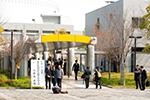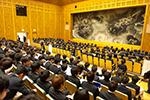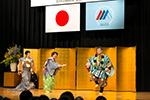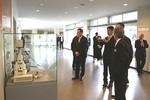2014/04/17
On Friday, April 4, 2014, an entrance ceremony was held in the Millennium Hall.
NAIST eagerly promotes admission of students whether from Japan or overseas with strong basic academic capabilities without being bound to a major field in university as well as researchers, engineers and others currently working actively in society who have clearly defined goals and aspirations for the future as well as strong interest and enthusiasm for research fields. This spring 426 graduate students were granted admission to NAIST.
At the ceremony, Mr. Tsutomu Maeda, the Vice Governor of Nara Prefecture, Mr. Makoto Yamashita, the Mayor of Ikoma City, Mr. Hiroshi Koyama, the Executive Director of the Foundation for NAIST, Dr. Shoji Komai, the Head of NAIST Alumni Association were invited as guests. There was a performance of "Kagyu (The Snail)", Okura School of Kyogen by the Shigeyama Family.
After the ceremony, the President and Executive Directors guided the guests to the commemorative nameplate in recognition of the winning of Nobel Prize by Shinya Yamanaka, our Honorary Professor and had a friendly conversation with them about mutual exchange between NAIST and municipality.
*Number of Enrollees in April
[Master's Course]
Information Science 127 (7 international students)
Biological Sciences 115 (4 international students)
Materials Science 106 (2 international students)
[Doctoral Course]
Information Science 24 (12 international students)
Biological Sciences 25 (4 international students)
Materials Science 29 (6 international students)
Total 426 (35 international students)
[Congratulatory Remarks to Entering Students, Entrance Ceremony, Spring 2014]
I would like to express my heartfelt congratulations to the 348 students of the master's course and the 78 students of the doctoral course that entered NAIST today. On behalf of the 200 faculty and 150 staff members, I welcome you. I would also like to express my congratulations to the families of the students entering NAIST today.
Among the new students today, there are 35students from 15 countries around the world entering the university. I would like to express my respect for you in choosing to study in Japan. About ten days ago, 27 international students received their degrees and, including the 35 international students entering NAIST today, there are 146 international students from 39 different countries and areas; they comprise 14% of the 1020 NAIST students. With the current mobility of people, materials, and information in our connected, borderless world today, the economic growth in Asia and Africa is continuing.
Until now, Japanese universities were prone to limiting their focus domestically, but now the further globalization of universities is being demanded in order to accept students from around the world to spread Japanese science and technology research, and to introduce Japanese society and culture.It is also considered essential to expose Japanese students to ideas and cultures from around the world, and to the needs being placed on science and technology at the global level. I hope Japanese students will take full advantage of NAIST's global education and research environments to broaden your perspectives internationally. Also, I hope the international students entering NAIST today will interact with not only Japanese students, but also with students from all over the world in both your studies and in your everyday lives. We at NAIST will actively prepare opportunities for this important exchange.
I hope that all of the students entering the master's program will undertake new and challenging endeavors. You have all left your previous institutions and entered NAIST with various hopes, some to further studies in your chosen field and some to pursue new research areas. Here at NAIST, no matter which laboratory you join or what area of studies you choose to pursue, a great many possibilities are available to you. I was engaged in microbiological research as a professor of NAIST for 20 years and every year many students who had completed undergraduate research on microorganisms visited me to learn more about the research I did, because they wanted to continue their research. At that time I told the students to not just assume that their previous research was the most interesting, but instead that they should look into research in various areas including animal and plant research before deciding the laboratory they will join. Introductions of the graduate schools and laboratories will begin shortly, so please consider all the possibilities that are here at NAIST without any preconceptions. There may be intriguing research areas that you have never encountered or considered. Last year NAIST held a contest for a memorable slogan to describe NAIST, and the slogan 'Outgrow Your Limits' was chosen to express the endless possibilities in pursuing your future here.
As you probably know, NAIST was established in October 1991, as a newly conceived independent graduate university. In the establishment of NAIST the following ideas were put forth as the guiding mission of our institute's education and research. The fields of frontier science and technology have the following characteristics:
・produce innovative, wide-ranging, and interdisciplinary, developments from fundamental research
・produce new knowledge from fundamental research which results in technological developments in very short periods
・in turn, technological developments become the base of fundamental research and make further progress possible
・thus, high integration of science and technology is clearly evident
With this in mind, it is crucial to promote interdisciplinary fundamental research that reaches beyond traditional academic divisions. The following is also stated concerning education: With the rapid developments in the areas of frontier science and technology, an important issue for both academic research and industry is the organized fostering of researchers and technicians to undertake the research and development in these fields. Especially in these fields, the training of human resources who can respond flexibly to developments in science and technology, and are capable of continuously pursuing new fields of research is necessary. In other words, NAIST was founded to conduct interdisciplinary research, integrating science and technology, extending past established areas of studies such as engineering, physical science, agriculture and medical science, in the rapid developing frontier science and technology fields of information, biological and materials sciences. With this as our foundation, NAIST develops human resources that actively adjust to developments in science and technology, and are competent at continually cultivating new areas of research. NAIST's education and research mission, which has since been revised to include global perspectives, was pioneering from the start and continues to represent the ideas necessary for society today.
Furthermore, with enthusiastic research faculty members from various backgrounds actively performing research activities, and through organized graduate school education based on this research, NAIST has conferred master's degrees to 6249 students and doctoral degrees to 1225 students. NAIST's research and education activities have been evaluated very highly in rankings and in the MEXT national university education and research results evaluation. Last year MEXT chose 22 institutions for its Program for Promoting the Enhancement of Research Universities in order to further promote globalization and research abilities. NAIST was one of the institutions chosen.
In relation to NAIST's education and research mission, the present science and technology is changing greatly. 21st century science is now thought to deal with complex systems in all disciplines. The new keyword for information sciences is "big data". We are now in an era where computer, sensor and network efficiency has improved greatly, the entire world is connected together in real time through the internet, and the world's various data is utilized comprehensively. A result of this is the expectation of a new world to be created and supported by ICT technology. This technology is expected to revolutionize various fields, such as energy, transportation, social care, and agriculture. Through revolutions in genome DNA sequence analysis technology, research has come to the point where we can easily determine the genome sequence of living things including our own individual genomes,
and we can explore molecular bases of the diversity of living organisms. Also, this is an era in which we can collect huge amounts of data concerning the activities of various cells and living organisms. As a result, in bioscience, the era of understanding various individual processes has shifted to an era of understanding of how those processes work collectively and diversely in living organisms and how various living organisms mutually affect each other in the earth's environment. As can be understood from the term 'big data biology', there is a paradigm shift occurring where the statistical analysis of huge amounts of data is leading actual experimental biology. Furthermore, in materials science, advancements in analysis and measurement technology have uncovered an advanced world of materials, allowing for the creation of new materials that were unimaginable twenty years ago. With these science and technological advancements new interdisciplinary fields of research are being created covering information, biological and materials sciences, such as the integrated field of computational biology from information and biological sciences. The distance between fundamental science and technology and their resultant developments in society is much shorter than 20 years ago. I believe that when you graduate from NAIST and take positions as researchers and technicians in society, the impact of the developments in science and technology will be farther reaching than we can imagine now.
Additionally, as can be seen in the economic development of Asian and African countries, the world is changing rapidly. This rapid change underscores the importance of creating new science and technology to reduce the use of our Earth's energy and resources, to balance the problems of global warming with the needs and activities of society, and to create a sustainable society. For example, a recently released report from the Ministry of Environment has stated that if the current world production of greenhouse gases continues unchanged, by the end of the century it is possible the average temperature will rise 3.5 to 6.4 degrees, and areas beside Hokkaido will become subtropical regions. Moreover, in a report released by the UN, the world population might increase from 7 billion to 9.3 billion by the year 2050, leading to a 55% rise in water needs and therefore over 40% of the earth's population will face extreme water shortage. Apart from these global issues, Japan also faces local problems including a rapidly decreasing population combined with a rapidly aging society, and also maintain and improve Japan's vitality in such an environment. For this reason, it is necessary to abandon the conventional business model in favor of innovative reform with a global perspective. For this, collaboration among researchers and technicians from various disciplines is being pursued to discover new issues that must be solved and to lead to creative answers for the solution of these issues.
It is said that there must now be a shift from a society that pursues uniform affluence and convenience to a sustainable society where varied affluence is pursued, but the creation and utilization of such an unprecedented new world requires human resources that are ready to meet this challenge. In order to create a new world through the creation and application of new science and technology on the frontline of this future society, I hope you attain specialized knowledge and holistic vision so you can respond flexibly to the quickly developing science and technology, and continue discovering new areas of research, while also achieving various disciplines of knowledge, multicultural communication skills and collaboration skills. For this, it is important to develop the ability to view and use the trends of various fields creatively, without being locked into your own area of expertise. From now you will all enter different laboratories and continue your studies and research, but you may be able to achieve interesting results through the adoption of methods and ideas from other laboratories. At NAIST the walls between each laboratory and graduate school are intentionally low, so I hope you interact with a wide variety of people.
Recently, cases concerning the social responsibility and morality of scientists and researchers have gained attention in the news. A researcher's integrity is a prerequisite for research activities. Accordingly, rules that must be followed, i.e. morality as a researcher, technician, or specialist, are important for any activity.
Finally, I hope you lead happy and healthy lives while studying here at NAIST. In starting your new lives here, you will all meet many new people. Then, in making friends, building ties, and establishing networks through your studies, you will not only expand your range of studies and research activities, but this will also support you in your life here and become a treasure that will be a part of your entire life.
I address you today with great expectations that your student lives, and indeed your futures, will be purposeful and significant. Congratulations once again on entering NAIST. All members of the faculty and staff welcome you wholeheartedly.
President Naotake Ogasawara,
Nara Institute of Science and Technology, April 4, 2014









